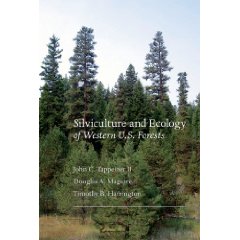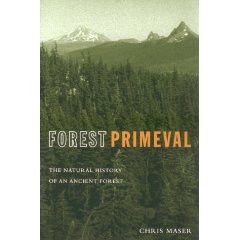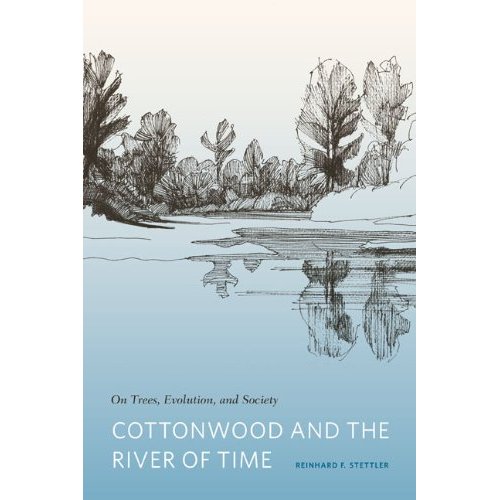I’ve now placed an order for books, and they are listed below. The ecoforestry book and the silviculture text will be texts that should compliment eachother well, and deal directly with impacts of forestry activities – you will have weekly assigned readings from these books. They will accompany lectures and content related to traditional and new forestry. We will also use some of the ecoforestry chapters in seminar. The other three books will be essential seminar reads. I’ve also listed them in the order that we will be reading them. Our three seminar books will be read with “Forest Primeval” first, then “The Golden Spruce”, and finally “Cottonwood and the River of Time”. Several seminars and assigned readings will also be technical papers from journals like “Ecosystems”, and “Journal of Forestry”. At least one seminar (week 1) will be on a film, “Sometimes a Great Notion” – a Paul Newman adaptation of the Kesey book by the same title. I’m considering a couple other seminar films, but I’ll have to work on how we squeeze them into the already tight schedule (probably an optional “out of class” film series coupled with placing each film on closed reserve in the library).








Books:
Silviculture and Ecology of Western U.S. Forests
by John C. Tappeiner, Douglas A. Maguire, and Timothy B. Harrington
Ecoforestry: The Art and Science of Sustainable Forest Use by Alan Drengson, Duncan Taylor, and Duncan M. Taylor
Forest Primeval: The Natural History of an Ancient Forest
By Chris Maser
The Golden Spruce: A True Story of Myth, Madness, and Greed
by John Vaillant
Cottonwood and the River of Time: On Trees, Evolution, and Society
By Reinhard F. Stettler
November 22nd, 2009 at 1:26 am
According to the description and sample pages available on Amazon, I think Wintergreen looks like a good book for our program. I like the poetic nature of the writing and I think it will cause us to begin to think about the forest in a more integrated manner, as an integrated system of micro-ecosystems.
November 22nd, 2009 at 1:30 am
Ecoforestry also looks good for our program. I like that it appears to be a collection of short articles. That sort of compilation textbook often makes it easier for me to concentrate than a long textbook with one chapter after another written by the same author.
There was no information about Forst Primeval on Amazon so I do not know how well this would fit into our program.
The other two books I already own so either using them or not works well for my finances.
I hope these comments are useful.
November 22nd, 2009 at 7:44 pm
I really love the ecoforestry book, the first out of two books by the same authors, they all attempt to link theory (deep ecology, “wholistic” thinking and systems theory)with practice (what would this actually look like). The other book is wild foresting, which I sort of see as ecoforestry second edition.
I read those two books back in Olympic Peninsula as sort of a literary “foil” to Tappiener et al. and found the dichotomies of how “sustainable” is defined and experimented with rewarding.
There is also the book Good Forestry: From Good Theories and Good Practices by this guy Alan Wittbecker. I have only flipped through it but it seemed like a good companion with the other two texts since it is more or less an ecoforestry a la carte of essays with a heavy dose of philosophy the beginning chapters, but some interesting case studies towards the end.
There used to be an ecoforestry journal that you can access the archives from (http://www.ecoforestry.ca/journal.htm)
Other good books are
Beloved of the Sky: Essays on clearcutting which I though was just great, a lot similar to working the woods working the sea. It is a collection of essays by various northwest coast environmentalists, loggers, writers, and foresters, and backcountry woodsfolk on leaving and coming to terms within a landscape dominated by the dominant industrial forestry paradigm. I would even recommend doing working the woods working the sea again, it was such a great humanizing text, that we never really got to delve into with Olympic Peninsula.
There is a pretty new book that came out (2008) that I read over the summer that I felt was a really good “state of affairs” of where the direction of forestry is going in America, especially on public lands. Its called Forests Forever: Their Ecology, Restoration, and Protection by John Berger. Its mostly heavy on how they have been managed, and forest policy, but its a really solid read, and in some respects would put the ecoforestry texts, forest primeval (and most of what Chris Maser writes the redesigned forest etc) and the golden spruce in a more relevant perspective from the 80s-90s.
November 29th, 2009 at 1:13 pm
A really good book that i got last year that might be good for this class talks about the forestry practices throughout North America and it speaks a lot about the Forest Service, and the many political fights that happened in court. its Called “Forests Forever; Their Ecology, Restoration, and Protection.” by John J. Berger
December 1st, 2009 at 7:17 pm
These look exciting! I’d also love to read texts/articles focusing specifically on indigenous forest resource management. I think it is often overlooked and very important to learn about how people have been consciously managing and tending our local ecosystems for thousands of years. When I learn about this, I am always left with specific questions: What did they do specifically to create abundance and diversity in the landscape? Why did it work? How do we use this traditional knowledge to inform the field of ecoforestry? What are the politics of modern forestry in the context of indigenous land rights, and how can we use traditional knowledge and be allies of the scientific world?
Exploring these questions in depth is beyond the scope of this program, no doubt, but a little dabbling might be possible? I am interested in the book “Tending the Wild” by Kat Anderson. There is an interesting chapter in it about cultivating woody species, as well as just good thoughts about the people-land relationship.
December 1st, 2009 at 9:35 pm
The book you suggest sounds great. The book Adam mentioned (Wild Foresting) has a few chapters on native american perspectives, but it leaves out some critical ecology concepts. I am also rethinking the book “working the woods working the sea” that Adam mentioned above. It would be a re-run for anyone from Olympic Peninsula last year, but it has a broad diversity of perspectives, and it’s a really nice book… more later
December 2nd, 2009 at 7:30 pm
Hey heron,
unfortunately, there is really not many “popular” books on indigenous and native peoples forest management. There are a few books out there on the tropical rainforests, but relatively little from out here. If anything Nancy Turner (The Earth’s Blanket, Keeping it Living) is as close as I can find. Most of the indigenous “work” has been up in BC. There is also the book “Tongass” that is a anthology of essays about forestry up in Alaska that have some good pieces.
So There are some more forest history books about Clayoquot sound that are good, that I can’t remember the names of right now. But, if you are really interested I have some papers and reports about modern Indian land management, specifically around fire management. The information is out there, but mostly back cataloged in government reports and tribal reports (that some good internet sleuthing would help with). if you email me I can send you some good pdfs, or post them on here somewhere if that is possible.
December 10th, 2009 at 6:46 pm
It looks like there’s going to be a recall/hold war over the books in the library. Every book I check out gets recalled. We should figure something out.